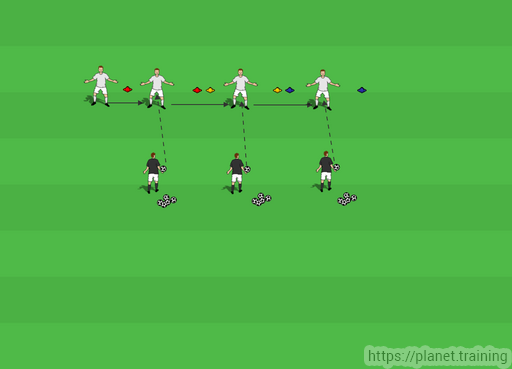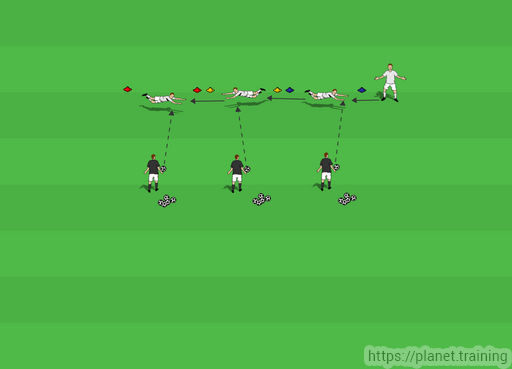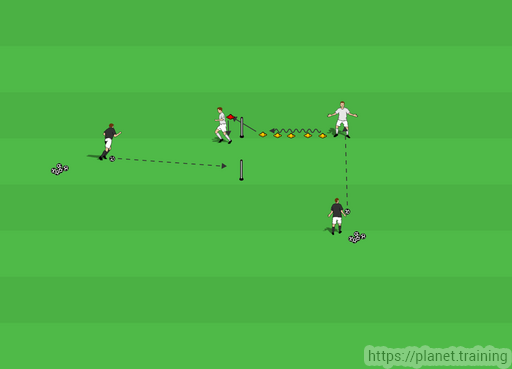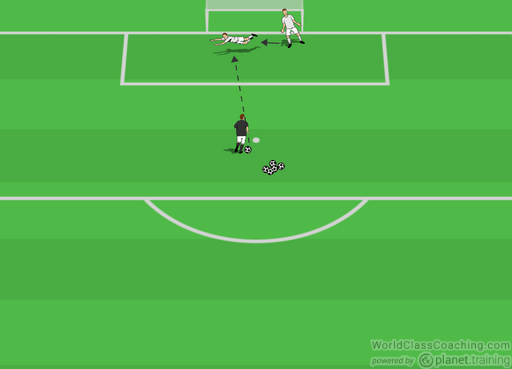- You are here:
- Home »
- Goalkeeping »
- Explosive Movement across the Goal to Save
Explosive Movement across the Goal to Save
By Scott Housden –
As is the case for all other players, the goalkeeper moves considerably during games. Nevertheless, only a few of these movements undertaken serve to fulfil the defensive duties of the goalkeeper. Active movement (i.e. the goalkeeper’s movement on the pitch to ensure good positioning before attempting to make a save) across the goalmouth is key when dealing with a number of scenarios from cut-back crosses and deep crosses to second phase saves when the goalkeeper has either deflected the ball or the ball has deflected off an outfield player
These drills outlined below will allow you to work on this active movement that is an essential part of goalkeeping defensive duties.
Set Up 1
- Goalkeeper starts to the side of one of the two outside mini goals (indicated by red or blue coloured cones).
- On the servers call the goalkeeper moves with lateral using sidesteps into the first goal and gets in line with the server and gets into the ‘set’ position (sets) to make a simple save from a volley (or throw) from the server.
- The goalkeeper return the ball and continues into the next coloured goal, repeats, and then into the final coloured goal and repeats.
- Repeat drill starting from the other side.

Coaching Points
As outlined above, this type of Active movement by a goalkeeper is essential in a number of scenarios during a game. Therefore, it is essential that even this basic movement is undertaken with efficiency, awareness and balance.
- Lateral movement must be level across the drill (i.e. not moving forward or backward), with the goalkeeper’s height also remaining constant when moving.
- Always look at the ball in play and have your hands in the ‘ready’ position when moving.
- Try to remain balanced and take smaller quick steps rather than larger steps (this allows the goalkeeper to remain balanced).
- Slow down as the attacker pulls back the kicking foot.
- Set in line with the server (remember ‘nose over toes’), make the save and be ready to move quickly to the next save.
Progression 1
The drill is repeated. However, this time the goalkeeper has to move more quickly across the drill. This is achieved by using crossover steps (sideways running) whilst facing the ball at all times
- The server puts in a more challenging low shot into either side of the coloured mini goal, forcing the goalkeeper to dive.
- Each time the servers must wait for the goalkeeper to set in line with the server before shooting.

Realistically, we are simulating a larger distance across the goalmouth (i.e. post to post) with this progression and so quicker balanced movement is required by the goalkeeper.
- Crossover steps (bringing the back foot across the front foot each time) must be level across the drill (i.e. not moving forward or backward or arced), with the goalkeeper’s height also remaining constant when moving.
- This level movement across the goal is key as it is not only the most direct route across the goal but it will also allow the goalkeeper to ‘attack’ the ball when making a diving save.
- Always look at the ball in play and have your hands in the ‘ready’ position when moving.
- Try to remain balanced and take smaller quick steps rather than larger steps (this allows the goalkeeper to remain balanced).
- Slow down as the attacker pulls back the kicking foot.
- The last step before getting in line with the server will need to be a lateral step so that the goalkeeper can get into a balances ‘set’ position
- Set in line with the server (remember ‘nose over toes’), make the save and be ready to move quickly to the next save.
Progression 2

- The goalkeeper makes a simple save from the server before moving over the cones using quick crossover steps.
- The goalkeeper then quickly changes direction and moves to touch the red cone with their hand before continuing into the small goal again using crossover steps
- The server shoots low before allowing the goalkeeper to ‘set’, aiming for the far post.
- The goalkeeper must adjust their steps so they are able to make a diving save (pushing off their front foot into the dive).
- Remember to perform the drill on both sides.
Coaching Points
- Quick balanced crossover footwork across the cones with a quick change of direction to the red cone.
- Take shorter faster steps towards the red cone as well so as to remain balanced and ready to change direction again at the cone.
- After touching the cone, focus on the ball and take initial crossover steps to cover the distance quickly again levelling off across the goal with your height remaining constant.
- Adjust you steps just prior to the shot so you are able to push and drive off your front foot and attack the ball in your dive.
Progression 3

This final progression simulates a cut-back cross scenario where the ball has been cut back to an attacker on the penalty spot. Therefore quick levelled off crossover movement across the goalmouth is essential.
- The goalkeeper starts the drill close to the near post in preparation for what would be a cut-back cross.
- The goalkeeper then commences the drill by calling ‘Away’ (as they are not able to collect this pretend cut-back cross).
- They then make quick levelled off crossover movement across the goalmouth to get in line with the attacker.
- The attacker aims their shot for the far post as soon as the goalkeeper is in line with them (not allowing the goalkeeper to set).
By Scott Housden
Scott is both a UEFA ‘B’ and UEFA ‘B’ Goalkeeping Coach and holds a Masters in Sports Management. He has been a goalkeeper coach in professional football in the UK and Australia at First Team, Academy and Women’s levels. He currently runs a Goalkeeper Academy in the Western Suburbs of Brisbane, Australia.
